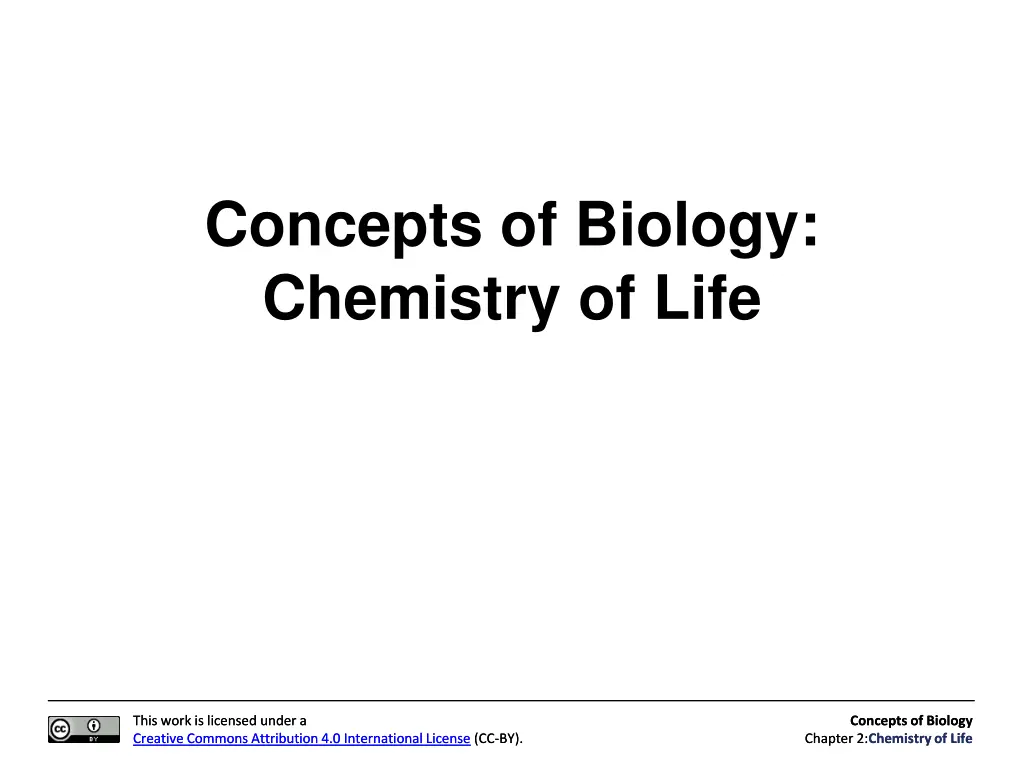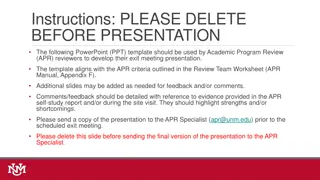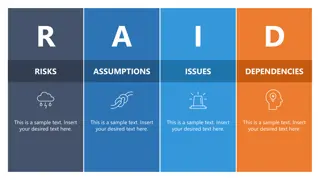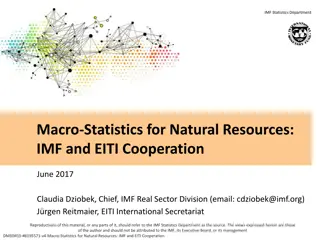
Understanding the Chemistry of Life in Biology
Explore the foundational concepts of the chemistry of life in biology, delving into atoms, molecules, and bonds at the atomic level. Discover how organisms rely on the properties and shapes of molecules determined by the nature of atoms and bonding. Gain insights into the importance of understanding atomic structure for topics like enzymes, genes, and nutrition.
Download Presentation

Please find below an Image/Link to download the presentation.
The content on the website is provided AS IS for your information and personal use only. It may not be sold, licensed, or shared on other websites without obtaining consent from the author. If you encounter any issues during the download, it is possible that the publisher has removed the file from their server.
You are allowed to download the files provided on this website for personal or commercial use, subject to the condition that they are used lawfully. All files are the property of their respective owners.
The content on the website is provided AS IS for your information and personal use only. It may not be sold, licensed, or shared on other websites without obtaining consent from the author.
E N D
Presentation Transcript
Concepts of Biology: Chemistry of Life Creative Commons Attribution 4.0 International License This work is licensed under a Creative Commons Attribution 4.0 International License (CC-BY). Creative Commons Attribution 4.0 International License (CC-BY). Creative Commons Attribution 4.0 International License This work is licensed under a Concepts of Biology Chapter 2:Chemistry of Life Chapter 2:Chemistry of Life Concepts of Biology
Figure 2.1 Foods such as bread, fruit, and cheese are rich sources of biological macromolecules. (credit: modification of work by Bengt Nyman) Creative Commons Attribution 4.0 International License This work is licensed under a Creative Commons Attribution 4.0 International License (CC-BY). Creative Commons Attribution 4.0 International License (CC-BY). Creative Commons Attribution 4.0 International License This work is licensed under a Concepts of Biology Chapter 2:Chemistry of Life Chapter 2:Chemistry of Life Concepts of Biology
Students are often surprised that we need to go down to the atomic level in this Biology course. Organisms depend on the properties of molecules and the shape of those molecules and the property and shape depends on the nature of the atoms and the way that they are bonded. There are a few specific aspects of atoms and bonds that you will need to be familiar with. These concepts will come up again when we talk of enzymes, genes, nutrition, etc. Creative Commons Attribution 4.0 International License This work is licensed under a Creative Commons Attribution 4.0 International License (CC-BY). Creative Commons Attribution 4.0 International License (CC-BY). Creative Commons Attribution 4.0 International License This work is licensed under a Concepts of Biology Chapter 2:Chemistry of Life Chapter 2:Chemistry of Life Concepts of Biology
Figure 2.2 Atoms are made up of protons and neutrons located within the nucleus, and electrons surrounding the nucleus. Creative Commons Attribution 4.0 International License This work is licensed under a Creative Commons Attribution 4.0 International License (CC-BY). Creative Commons Attribution 4.0 International License (CC-BY). Creative Commons Attribution 4.0 International License This work is licensed under a Concepts of Biology Chapter 2:Chemistry of Life Chapter 2:Chemistry of Life Concepts of Biology
Creative Commons Attribution 4.0 International License This work is licensed under a Creative Commons Attribution 4.0 International License (CC-BY). Creative Commons Attribution 4.0 International License (CC-BY). Creative Commons Attribution 4.0 International License This work is licensed under a Concepts of Biology Chapter 2:Chemistry of Life Chapter 2:Chemistry of Life Concepts of Biology
Creative Commons Attribution 4.0 International License This work is licensed under a Creative Commons Attribution 4.0 International License (CC-BY). Creative Commons Attribution 4.0 International License (CC-BY). Creative Commons Attribution 4.0 International License This work is licensed under a Concepts of Biology Chapter 2:Chemistry of Life Chapter 2:Chemistry of Life Concepts of Biology
Protons define the element Creative Commons Attribution 4.0 International License This work is licensed under a Creative Commons Attribution 4.0 International License (CC-BY). Creative Commons Attribution 4.0 International License (CC-BY). Creative Commons Attribution 4.0 International License This work is licensed under a Concepts of Biology Chapter 2:Chemistry of Life Chapter 2:Chemistry of Life Concepts of Biology
Figure 2.3 Arranged in columns and rows based on the characteristics of the elements, the periodic table provides key information about the elements and how they might interact with each other to form molecules. Most periodic tables provide a key or legend to the information they contain. Creative Commons Attribution 4.0 International License This work is licensed under a Creative Commons Attribution 4.0 International License (CC-BY). Creative Commons Attribution 4.0 International License (CC-BY). Creative Commons Attribution 4.0 International License This work is licensed under a Concepts of Biology Chapter 2:Chemistry of Life Chapter 2:Chemistry of Life Concepts of Biology
Figure 2.4 The age of remains that contain carbon and are less than about 50,000 years old, such as this pygmy mammoth, can be determined using carbon dating. (credit: Bill Faulkner/ NPS) Creative Commons Attribution 4.0 International License This work is licensed under a Creative Commons Attribution 4.0 International License (CC-BY). Creative Commons Attribution 4.0 International License (CC-BY). Creative Commons Attribution 4.0 International License This work is licensed under a Concepts of Biology Chapter 2:Chemistry of Life Chapter 2:Chemistry of Life Concepts of Biology
Whatever is living takes in C. A tiny proportion is always C14. The ratio of C12 to C14 shifts over time. Half-life of 5700 years. You are what you eat. Dead things don t eat, therefore the clocks start ticking. Creative Commons Attribution 4.0 International License This work is licensed under a Creative Commons Attribution 4.0 International License (CC-BY). Creative Commons Attribution 4.0 International License (CC-BY). Creative Commons Attribution 4.0 International License This work is licensed under a Concepts of Biology Chapter 2:Chemistry of Life Chapter 2:Chemistry of Life Concepts of Biology
CONCEPT IN ACTION VIDEO http://phet.colorado.edu/en/simulation/isot opes-and-atomic-mass To learn more about atoms and isotopes, and how you can tell one isotope from another, visit the site (link above) and run the simulation. Creative Commons Attribution 4.0 International License This work is licensed under a Creative Commons Attribution 4.0 International License (CC-BY). Creative Commons Attribution 4.0 International License (CC-BY). Creative Commons Attribution 4.0 International License This work is licensed under a Concepts of Biology Chapter 2:Chemistry of Life Chapter 2:Chemistry of Life Concepts of Biology
Orbitals and Bonding Creative Commons Attribution 4.0 International License This work is licensed under a Creative Commons Attribution 4.0 International License (CC-BY). Creative Commons Attribution 4.0 International License (CC-BY). Creative Commons Attribution 4.0 International License This work is licensed under a Concepts of Biology Chapter 2:Chemistry of Life Chapter 2:Chemistry of Life Concepts of Biology
Figure 2.5 Elements tend to fill their outermost shells with electrons. To do this, they can either donate or accept electrons from other elements. Creative Commons Attribution 4.0 International License This work is licensed under a Creative Commons Attribution 4.0 International License (CC-BY). Creative Commons Attribution 4.0 International License (CC-BY). Creative Commons Attribution 4.0 International License This work is licensed under a Concepts of Biology Chapter 2:Chemistry of Life Chapter 2:Chemistry of Life Concepts of Biology
Ionic bond giving or taking electrons to fill outer shells This giving and taking of electrons results in a charge on the element and the charge differential creates attraction. Know NaCl as the example Creative Commons Attribution 4.0 International License This work is licensed under a Creative Commons Attribution 4.0 International License (CC-BY). Creative Commons Attribution 4.0 International License (CC-BY). Creative Commons Attribution 4.0 International License This work is licensed under a Concepts of Biology Chapter 2:Chemistry of Life Chapter 2:Chemistry of Life Concepts of Biology
A covalent bond is a sharing of a pair of elements to fill their outer shells. Electrons can be shared equally when the atoms are identical (O-O, C-C), and also in the C-H bond. This is a nonpolar covalent bond. Equal sharing creates a nonpolar bond. Electrons can be shared unequally, as is the case with H-O-H (water), and this is a polar covalent bond. Creative Commons Attribution 4.0 International License This work is licensed under a Creative Commons Attribution 4.0 International License (CC-BY). Creative Commons Attribution 4.0 International License (CC-BY). Creative Commons Attribution 4.0 International License This work is licensed under a Concepts of Biology Chapter 2:Chemistry of Life Chapter 2:Chemistry of Life Concepts of Biology
Figure 2.6 The water molecule (left) depicts a polar bond with a slightly positive charge on the hydrogen atoms and a slightly negative charge on the oxygen. Examples of nonpolar bonds include methane (middle) and oxygen (right). Creative Commons Attribution 4.0 International License This work is licensed under a Creative Commons Attribution 4.0 International License (CC-BY). Creative Commons Attribution 4.0 International License (CC-BY). Creative Commons Attribution 4.0 International License This work is licensed under a Concepts of Biology Chapter 2:Chemistry of Life Chapter 2:Chemistry of Life Concepts of Biology
Oxygen Oxygen exerts a powerful pull on electrons, hence the unequal sharing of electrons. This property makes it both essential and deadly. Essential in cellular respiration as you will learn later to create ATP to sustain order and life. But deadly in its destruction of key molecules. Skin test collagen. Oxygen and aging. Dog with a cloudy eye. Beauty products are antioxidants vitamins, drinks etc. (Catalase Lab) link to products catalase pseudoscience link Creative Commons Attribution 4.0 International License This work is licensed under a Creative Commons Attribution 4.0 International License (CC-BY). Creative Commons Attribution 4.0 International License (CC-BY). Creative Commons Attribution 4.0 International License This work is licensed under a Concepts of Biology Chapter 2:Chemistry of Life Chapter 2:Chemistry of Life Concepts of Biology
Figure 2.7 Hydrogen bonds form between slightly positive ( +) and slightly negative ( ) charges of polar covalent molecules, such as water. Creative Commons Attribution 4.0 International License This work is licensed under a Creative Commons Attribution 4.0 International License (CC-BY). Creative Commons Attribution 4.0 International License (CC-BY). Creative Commons Attribution 4.0 International License This work is licensed under a Concepts of Biology Chapter 2:Chemistry of Life Chapter 2:Chemistry of Life Concepts of Biology
The partial charges across a polar bond give rise to hydrogen bonding which gives water its peculiar properties, like adhesion, cohesion. Creative Commons Attribution 4.0 International License This work is licensed under a Creative Commons Attribution 4.0 International License (CC-BY). Creative Commons Attribution 4.0 International License (CC-BY). Creative Commons Attribution 4.0 International License This work is licensed under a Concepts of Biology Chapter 2:Chemistry of Life Chapter 2:Chemistry of Life Concepts of Biology
Hydrophilic Hydrophobic Lipids are defined by being hydrophobic. Lipids are hydrocarbons made up of nonpolar covalent bonds. Hence, oil and water do not mix. Creative Commons Attribution 4.0 International License This work is licensed under a Creative Commons Attribution 4.0 International License (CC-BY). Creative Commons Attribution 4.0 International License (CC-BY). Creative Commons Attribution 4.0 International License This work is licensed under a Concepts of Biology Chapter 2:Chemistry of Life Chapter 2:Chemistry of Life Concepts of Biology
Figure 2.8 As this macroscopic image of oil and water show, oil is a nonpolar compound and, hence, will not dissolve in water. Oil and water do not mix. (credit: Gautam Dogra) Creative Commons Attribution 4.0 International License This work is licensed under a Creative Commons Attribution 4.0 International License (CC-BY). Creative Commons Attribution 4.0 International License (CC-BY). Creative Commons Attribution 4.0 International License This work is licensed under a Concepts of Biology Chapter 2:Chemistry of Life Chapter 2:Chemistry of Life Concepts of Biology
Figure 2.9 (a) The lattice structure of ice makes it less dense than the freely flowing molecules of liquid water. Ice s lower density enables it to (b) float on water. (credit a: modification of work by Jane Whitney; credit b: modification of work by Carlos Ponte) Creative Commons Attribution 4.0 International License This work is licensed under a Creative Commons Attribution 4.0 International License (CC-BY). Creative Commons Attribution 4.0 International License (CC-BY). Creative Commons Attribution 4.0 International License This work is licensed under a Concepts of Biology Chapter 2:Chemistry of Life Chapter 2:Chemistry of Life Concepts of Biology
Water Water is the strangest substance. You can t name another in which the solid floats on the liquid, that has a surface tension, and that dramatically shapes climate and life on earth. Water is most dense at 4 degrees C. Releases energy (and heat) and molecules move apart upon freezing. Problem plants on a balcony. Creative Commons Attribution 4.0 International License This work is licensed under a Creative Commons Attribution 4.0 International License (CC-BY). Creative Commons Attribution 4.0 International License (CC-BY). Creative Commons Attribution 4.0 International License This work is licensed under a Concepts of Biology Chapter 2:Chemistry of Life Chapter 2:Chemistry of Life Concepts of Biology
CONCEPT IN ACTION http://www.janewhitney.com/Ice_Movie_Re sources/ice_movie.mov Video error View the 3-D animation of the structure of an ice lattice. (credit: image created by Jane Whitney using Visual Molecular Dynamics (VMD) software1) Creative Commons Attribution 4.0 International License This work is licensed under a Creative Commons Attribution 4.0 International License (CC-BY). Creative Commons Attribution 4.0 International License (CC-BY). Creative Commons Attribution 4.0 International License This work is licensed under a Concepts of Biology Chapter 2:Chemistry of Life Chapter 2:Chemistry of Life Concepts of Biology
Figure 2.10 When table salt (NaCl) is mixed in water, spheres of hydration form around the ions. Creative Commons Attribution 4.0 International License This work is licensed under a Creative Commons Attribution 4.0 International License (CC-BY). Creative Commons Attribution 4.0 International License (CC-BY). Creative Commons Attribution 4.0 International License This work is licensed under a Concepts of Biology Chapter 2:Chemistry of Life Chapter 2:Chemistry of Life Concepts of Biology
Water Life is mostly water and all charged and partially charged molecules are soluble in water. Since water has positive and negative charges it can create a shell of water around charged entities. That is water happens when you put salt in water it disappears and is said to be soluble. This will be an important point when we discuss osmosis. Would there be a limit to how much salt you could dissolve in water why or why not? Creative Commons Attribution 4.0 International License This work is licensed under a Creative Commons Attribution 4.0 International License (CC-BY). Creative Commons Attribution 4.0 International License (CC-BY). Creative Commons Attribution 4.0 International License This work is licensed under a Concepts of Biology Chapter 2:Chemistry of Life Chapter 2:Chemistry of Life Concepts of Biology
Can you explain why water does not act as a solvent for fats? Creative Commons Attribution 4.0 International License This work is licensed under a Creative Commons Attribution 4.0 International License (CC-BY). Creative Commons Attribution 4.0 International License (CC-BY). Creative Commons Attribution 4.0 International License This work is licensed under a Concepts of Biology Chapter 2:Chemistry of Life Chapter 2:Chemistry of Life Concepts of Biology
Figure 2.11 The weight of a needle on top of water pulls the surface tension downward; at the same time, the surface tension of the water is pulling it up, suspending the needle on the surface of the water and keeping it from sinking. Notice the indentation in the water around the needle. (credit: Cory Zanker) Creative Commons Attribution 4.0 International License This work is licensed under a Creative Commons Attribution 4.0 International License (CC-BY). Creative Commons Attribution 4.0 International License (CC-BY). Creative Commons Attribution 4.0 International License This work is licensed under a Concepts of Biology Chapter 2:Chemistry of Life Chapter 2:Chemistry of Life Concepts of Biology
Trillions of weak hydrogen bonds gives structure to water. This allows a needle to float, pulls water from roots to a treetop, makes water hard to heat and slow to cool. What is temperature and what does temperature measure? Why is water hard to heat compared to other substances? Why is Victoria s climate better than Edmonton s? How specifically does sweating cool you? Creative Commons Attribution 4.0 International License This work is licensed under a Creative Commons Attribution 4.0 International License (CC-BY). Creative Commons Attribution 4.0 International License (CC-BY). Creative Commons Attribution 4.0 International License This work is licensed under a Concepts of Biology Chapter 2:Chemistry of Life Chapter 2:Chemistry of Life Concepts of Biology
Figure 2.12 The pH scale measures the amount of hydrogen ions (H+) in a substance. (credit: modification of work by Edward Stevens) Creative Commons Attribution 4.0 International License This work is licensed under a Creative Commons Attribution 4.0 International License (CC-BY). Concepts of Biology Chapter 2:Chemistry of Life
pH Normal blood pH is 7.38. Changes +/- 0.5 pH would be fatal. Homeostatic mechanisms, including respiration rate and buffers, keep pH in a tolerable range. The pH scale is orders of magnitude like the Richter scale. Acids add H+ (protons); bases add OH-. Buffers can add or eliminate H+ to stabilize pH. Bicarbonate equation here (double arrows) Creative Commons Attribution 4.0 International License This work is licensed under a Creative Commons Attribution 4.0 International License (CC-BY). Creative Commons Attribution 4.0 International License (CC-BY). Creative Commons Attribution 4.0 International License This work is licensed under a Concepts of Biology Chapter 2:Chemistry of Life Chapter 2:Chemistry of Life Concepts of Biology
Figure 2.13 Carbon can form four covalent bonds to create an organic molecule. The simplest carbon molecule is methane (CH4), depicted here. Creative Commons Attribution 4.0 International License This work is licensed under a Creative Commons Attribution 4.0 International License (CC-BY). Creative Commons Attribution 4.0 International License (CC-BY). Creative Commons Attribution 4.0 International License This work is licensed under a Concepts of Biology Chapter 2:Chemistry of Life Chapter 2:Chemistry of Life Concepts of Biology
Carbon All life is carbon-based. Carbon is fundamental because of the vast variety of shapes that the molecules made from it can assume. Creative Commons Attribution 4.0 International License This work is licensed under a Creative Commons Attribution 4.0 International License (CC-BY). Creative Commons Attribution 4.0 International License (CC-BY). Creative Commons Attribution 4.0 International License This work is licensed under a Concepts of Biology Chapter 2:Chemistry of Life Chapter 2:Chemistry of Life Concepts of Biology
Biological molecules All life is made of these 4 categories of molecules: Carbohydrates Proteins Lipids Nucleic Acids All fulfill similar functions in all organisms. Creative Commons Attribution 4.0 International License This work is licensed under a Creative Commons Attribution 4.0 International License (CC-BY). Creative Commons Attribution 4.0 International License (CC-BY). Creative Commons Attribution 4.0 International License This work is licensed under a Concepts of Biology Chapter 2:Chemistry of Life Chapter 2:Chemistry of Life Concepts of Biology
Figure 2.14 These examples show three molecules (found in living organisms) that contain carbon atoms bonded in various ways to other carbon atoms and the atoms of other elements. (a) This molecule of stearic acid has a long chain of carbon atoms. (b) Glycine, a component of proteins, contains carbon, nitrogen, oxygen, and hydrogen atoms. (c) Glucose, a sugar, has a ring of carbon atoms and one oxygen atom. Creative Commons Attribution 4.0 International License This work is licensed under a Creative Commons Attribution 4.0 International License (CC-BY). Concepts of Biology Chapter 2:Chemistry of Life
Carbohydrates Built on the (CH2O)n formula. C6H12O6 They function as energy sources. They also have structural functions, play a role in cellular identification (blood type). Creative Commons Attribution 4.0 International License This work is licensed under a Creative Commons Attribution 4.0 International License (CC-BY). Creative Commons Attribution 4.0 International License (CC-BY). Creative Commons Attribution 4.0 International License This work is licensed under a Concepts of Biology Chapter 2:Chemistry of Life Chapter 2:Chemistry of Life Concepts of Biology
Figure 2.15 Glucose, galactose, and fructose are isomeric monosaccharides, meaning that they have the same chemical formula but slightly different structures. Creative Commons Attribution 4.0 International License This work is licensed under a Creative Commons Attribution 4.0 International License (CC-BY). Creative Commons Attribution 4.0 International License (CC-BY). Creative Commons Attribution 4.0 International License This work is licensed under a Concepts of Biology Chapter 2:Chemistry of Life Chapter 2:Chemistry of Life Concepts of Biology
Sugars are soluble because they are more than hydrocarbons the OH groups make for partial charges. Which has more calories per gram? Frosted Flakes or Special K? Creative Commons Attribution 4.0 International License This work is licensed under a Creative Commons Attribution 4.0 International License (CC-BY). Creative Commons Attribution 4.0 International License (CC-BY). Creative Commons Attribution 4.0 International License This work is licensed under a Concepts of Biology Chapter 2:Chemistry of Life Chapter 2:Chemistry of Life Concepts of Biology
Disaccharides Sucrose and lactose are common disaccharides. (Lactase, lactose, lactose intolerance) Creative Commons Attribution 4.0 International License This work is licensed under a Creative Commons Attribution 4.0 International License (CC-BY). Creative Commons Attribution 4.0 International License (CC-BY). Creative Commons Attribution 4.0 International License This work is licensed under a Concepts of Biology Chapter 2:Chemistry of Life Chapter 2:Chemistry of Life Concepts of Biology
Figure 2.16 Although their structures and functions differ, all polysaccharide carbohydrates are made up of monosaccharides and have the chemical formula (CH2O)n. Creative Commons Attribution 4.0 International License This work is licensed under a Creative Commons Attribution 4.0 International License (CC-BY). Creative Commons Attribution 4.0 International License (CC-BY). Creative Commons Attribution 4.0 International License This work is licensed under a Concepts of Biology Chapter 2:Chemistry of Life Chapter 2:Chemistry of Life Concepts of Biology
Starch vs. Cellulose (enzymes, termites, why can t we eat cellulose for energy?) Creative Commons Attribution 4.0 International License This work is licensed under a Creative Commons Attribution 4.0 International License (CC-BY). Creative Commons Attribution 4.0 International License (CC-BY). Creative Commons Attribution 4.0 International License This work is licensed under a Concepts of Biology Chapter 2:Chemistry of Life Chapter 2:Chemistry of Life Concepts of Biology
Figure 2.17 Hydrophobic lipids in the fur of aquatic mammals, such as this river otter, protect them from the elements. (credit: Ken Bosma) Creative Commons Attribution 4.0 International License This work is licensed under a Creative Commons Attribution 4.0 International License (CC-BY). Creative Commons Attribution 4.0 International License (CC-BY). Creative Commons Attribution 4.0 International License This work is licensed under a Concepts of Biology Chapter 2:Chemistry of Life Chapter 2:Chemistry of Life Concepts of Biology
Lipids Diverse non-polymeric molecules common feature is being hydrophobic fats, earwax, steroid hormones Creative Commons Attribution 4.0 International License This work is licensed under a Creative Commons Attribution 4.0 International License (CC-BY). Creative Commons Attribution 4.0 International License (CC-BY). Creative Commons Attribution 4.0 International License This work is licensed under a Concepts of Biology Chapter 2:Chemistry of Life Chapter 2:Chemistry of Life Concepts of Biology
Figure 2.18 Lipids include fats, such as triglycerides, which are made up of fatty acids and glycerol, phospholipids, and steroids. Creative Commons Attribution 4.0 International License This work is licensed under a Creative Commons Attribution 4.0 International License (CC-BY). Creative Commons Attribution 4.0 International License (CC-BY). Creative Commons Attribution 4.0 International License This work is licensed under a Concepts of Biology Chapter 2:Chemistry of Life Chapter 2:Chemistry of Life Concepts of Biology
Why are there more calories in fats than proteins or carbohydrates? Saturated and unsaturated fats and behaviour at RT. Hydrogenation of vegetable oils in processed foods. Creative Commons Attribution 4.0 International License This work is licensed under a Creative Commons Attribution 4.0 International License (CC-BY). Creative Commons Attribution 4.0 International License (CC-BY). Creative Commons Attribution 4.0 International License This work is licensed under a Concepts of Biology Chapter 2:Chemistry of Life Chapter 2:Chemistry of Life Concepts of Biology
Creative Commons Attribution 4.0 International License This work is licensed under a Creative Commons Attribution 4.0 International License (CC-BY). Creative Commons Attribution 4.0 International License (CC-BY). Creative Commons Attribution 4.0 International License This work is licensed under a Concepts of Biology Chapter 2:Chemistry of Life Chapter 2:Chemistry of Life Concepts of Biology
Phospholipids This shape is crucial in their functioning in cell membrane bilayers. Creative Commons Attribution 4.0 International License This work is licensed under a Creative Commons Attribution 4.0 International License (CC-BY). Creative Commons Attribution 4.0 International License (CC-BY). Creative Commons Attribution 4.0 International License This work is licensed under a Concepts of Biology Chapter 2:Chemistry of Life Chapter 2:Chemistry of Life Concepts of Biology
Figure 2.19 During the hydrogenation process, the orientation around the double bonds is changed, making a trans-fat from a cis-fat. This changes the chemical properties of the molecule. Creative Commons Attribution 4.0 International License This work is licensed under a Creative Commons Attribution 4.0 International License (CC-BY). Creative Commons Attribution 4.0 International License (CC-BY). Creative Commons Attribution 4.0 International License This work is licensed under a Concepts of Biology Chapter 2:Chemistry of Life Chapter 2:Chemistry of Life Concepts of Biology
Trans fats we dont have the enzyme machinery to break them down. Creative Commons Attribution 4.0 International License This work is licensed under a Creative Commons Attribution 4.0 International License (CC-BY). Creative Commons Attribution 4.0 International License (CC-BY). Creative Commons Attribution 4.0 International License This work is licensed under a Concepts of Biology Chapter 2:Chemistry of Life Chapter 2:Chemistry of Life Concepts of Biology
CONCEPT IN ACTION https://www.wisc-online.com/learn/natural- science/life-science/ap13204/biomolecules-- the-lipids For an additional perspective on lipids, explore Biomolecules: The Lipids through the interactive animation (link above). Creative Commons Attribution 4.0 International License This work is licensed under a Creative Commons Attribution 4.0 International License (CC-BY). Creative Commons Attribution 4.0 International License (CC-BY). Creative Commons Attribution 4.0 International License This work is licensed under a Concepts of Biology Chapter 2:Chemistry of Life Chapter 2:Chemistry of Life Concepts of Biology






















